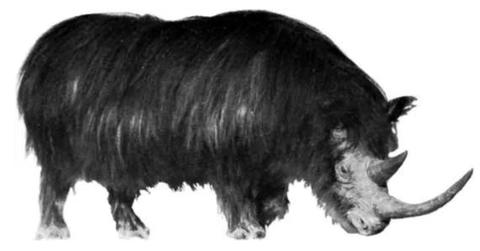Buried Marvel: Miners Unearth ‘Perfectly Preserved’ 10,000-Year-Old Woolly Rhinoceros in Russia

Woolly rhinoceros were found in northern Eurasia — of which Russia is a part — until at least 18,500 years ago.
Miners in Russia "struck gold" — figuratively — when they uncovered a remarkably intact carcass of a woolly rhinoceros, an animal that went extinct over 10,000 years ago.
The well-preserved body of this Ice Age mammal was discovered in Kolyma, far eastern Russia, Knewz.com reported. The region's permafrost likely contributed to the excellent condition of the carcass.
Initially, the miners found an oddly shaped lump, but after cleaning their curious find, they realized it was a member of the long-extinct species of megafauna native to the region.
The miners captured photos with the frozen woolly rhinoceros and a bulldozer in the background, creating a striking image of the ancient meeting the modern, which the photo can be seen here. The specimen is now being handed over to scientists for further examination.
Denis Petrov, a junior researcher at the Northeast Integrated Research Institute of the Far Eastern Branch of the Russian Academy of Sciences, said, "Any finds of entire mummified body fragments of the mammoth complex are a unique material for a wide range of studies that will allow you to learn new information about the individual development of animals, diet, living conditions."
Petrov added, "I really want to believe that this find, if it really exists, was made by responsible citizens who will pass it on to scientists."
- What Lies Beneath: NASA Scientist Believes Aliens May Have Found 'Perfect' Hiding Spot in Earth's Oceans
- Global Threat: Russia Insider Warns West of 'World War Using Nuclear Weapons' Amid Escalating Support for Ukraine
- Countdown to Disaster? Ex-NATO Official Warns Russia, Iran and China Could Wage WWIII in Just Years
The woolly rhinoceros roamed northern Eurasia, including parts of Russia, until at least 18,500 years ago. While their skulls resemble modern rhinos found in Asia and Africa, these Ice Age giants were significantly larger, with thick fur coats and two horns above their noses. They also inhabited temperate grasslands.
Over the years, several woolly rhinoceros specimens have been found frozen in Siberia and preserved in oil seeps in Central Europe. In 2020, another remarkably preserved woolly rhino was discovered in eastern Siberia by locals. Melting permafrost in the Abyisky region of Yakutia revealed the carcass, which retained most of its internal organs.
Never miss a story — sign up for the Front Page Detectives newsletter. Be on the scene the moment news breaks.
Valery Plotnikov, a researcher who examined the 2020 specimen, noted that the rhino was likely three to four years old at the time of death. Much of its soft tissue, including parts of its intestines and genitals, was still preserved.
The oldest known woolly rhinoceros specimen was discovered on the Tibetan plateau in 2007 and was deemed to be 3.6 million years old.
While theories suggest that humans hunted woolly rhinos to extinction, Britannica indicates that rapid climate change at the end of the Ice Age is a more likely cause.
Become a Front Page Detective
Sign up to receive breaking
Front Page Detectives
news and exclusive investigations.
